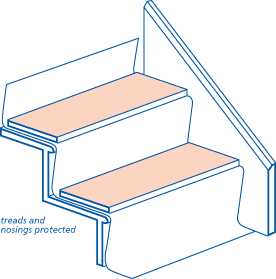6.6 Staircases
SITEWORK STANDARDS
(a) meet the Technical Requirements
(b) take account of the design
(c) follow established good practice and workmanship
Construction that follows the design and the guidance below will be acceptable for staircases.
LOCATION AND FIXING
Items to be taken into account include:
(a) headroom
The overall floor opening should be checked for size to accept the stairs and to allow sufficient headroom.
The minimum headroom above stairs should be measured vertically from the pitch line. The clear headroom (h) over the entire length and width of a stairway, including landings, should be 2.0m.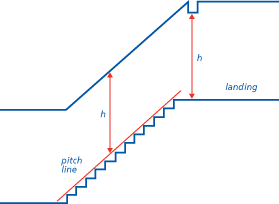
(b) overall vertical rise
Staircases are normally manufactured off site so the floor-to-floor dimensions should be accurate. An allowance should be made for floor finishes to structural floors or staircase treads.
(c) pitch
Staircases should be accurately located and fixed with the string at the correct angle so all treads are horizontal.
(d) landings
Landings, where required, should be properly framed to provide full support to and secure fixings for flights, nosings, newels, apron linings, etc.
(e) floor finishes
Allowance should be made for stair and floor finishes to ensure that all risers are equal.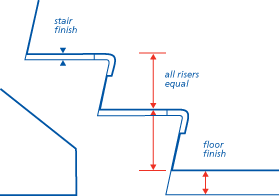
TIMBER STAIRCASES
(a) have secure component parts, including strings, treads and risers, newel posts, balusters and handrails
(b) be securely fixed to the supporting structure
Strings should be glued to newel posts and secured with dowels or screws. Particular attention should be given to winders; remedying problems, such as deflection and/or squeaking, can be difficult, especially if the soffit covering has been fixed.
Landings should be framed to provide full support and solid fixings for the tops of flights, nosings, newels, apron linings, etc.
Newel posts should be plumb and fixed securely.
The top nosing should be level with the floor decking and should be fixed firmly.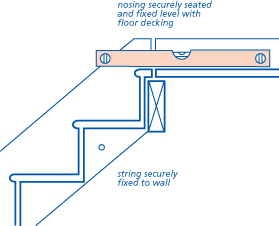
Finished joinery should be free from splits, knocks and other damage which would impair its structural performance or finish.
Handrails should have a smooth finish, free from rough edges. No handrail bracket or screw head should present a sharp edge.
Nails should be punched below the surface of the wood and stopped.
CONCRETE STAIRCASES
PRECAST CONSTRUCTION
When setting out levels, account should be taken of the thickness of finishes to the floor or landing, as well as any finish to be applied to the stair treads. Particular care is needed at the top and bottom of each flight.
Precast units should be accurately located and levelled.
IN-SITU CONSTRUCTION
Shuttering for in-situ concrete elements or connections should be accurately constructed to ensure a consistent rise and going.
FLOOR FINISHES
For both precast and in-situ staircases, allowance should be made for the thickness of finish at the top and bottom of flights.
Items to be taken into account include:
Chairs or spacing blocks should be used to give the following minimum cover to reinforcement:
| Minimum cover [mm] | |
| Internal staircases | 25 |
| Staircases open to the weather | 50 |
Allowance should be made for pre-formed nosings or non-slip finishes, if specified (see also Clause S5).
Formwork should be struck in accordance with the design, normally:
- side formwork - after 24 hours
- soffit and support formwork - after 28 days.
Reference should be made to Chapter 1.4 'Cold weather working' when concrete, mortar, grout or other materials containing water are used.
STEEL STAIRCASES
The supporting structure should be constructed within the tolerance limits set for the steel staircase. Treads should be checked for level. The correct fixings should be available.
Manufacturers' assembly and erection instructions should be available and followed.
HANDRAILS AND BALUSTRADES
A handrail should be provided for any flight that rises 600mm or more. The handrail should be fixed between 900mm (840mm in Scotland) and 1000mm vertically above the pitch line.
The ends of the handrail should be shaped or returned to the wall to prevent clothes catching on projections.
Throughout its whole length the handrail should be:
- fixed securely
- continuous
- smooth and unobstructed
- at least 25mm from any surface.
Check that fixing and location are in accordance with the design.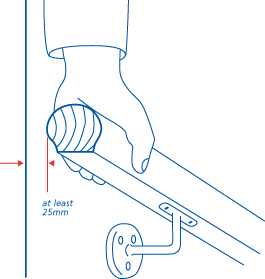
Statutory regulations require that balustrading:
- is fixed securely
- cannot be easily climbed, and
- has no gaps which would allow a 100mm diameter sphere to pass through.
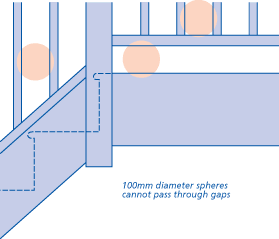
In concrete staircases, balustrading may be:
- grouted into pre-formed holes or pockets
- bolted or screwed into pre-drilled holes
- bolted to brackets cast into the concrete.
Fixing methods for balustrading should allow a degree of tolerance. It may be preferable to take measurements from the completed staircase, whether of in-situ or precast construction, before manufacturing the balustrading. This will ensure that the fixings are positioned correctly and allow for variations in the surrounding structure.
Design details on the spacing of bolt fixings for balustrades or handrails should be followed.
Care should be taken when using expanding fixings near the edges of concrete (whether in-situ or precast).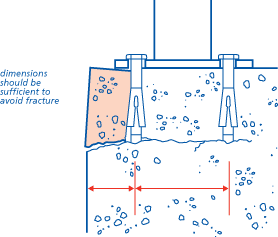
PROTECTION OF FINISHED WORK
When stored, staircases should be stacked on bearers. Wood staircases should be stored under cover and be fixed in place only when the building is weathertight.
Staircases, stair treads, nosings, balustrades and handrails may be protected with timber strips, plywood or building paper. Plastic sheeting should not be used to protect stairs because it gives a slippery surface which is not safe to walk on.